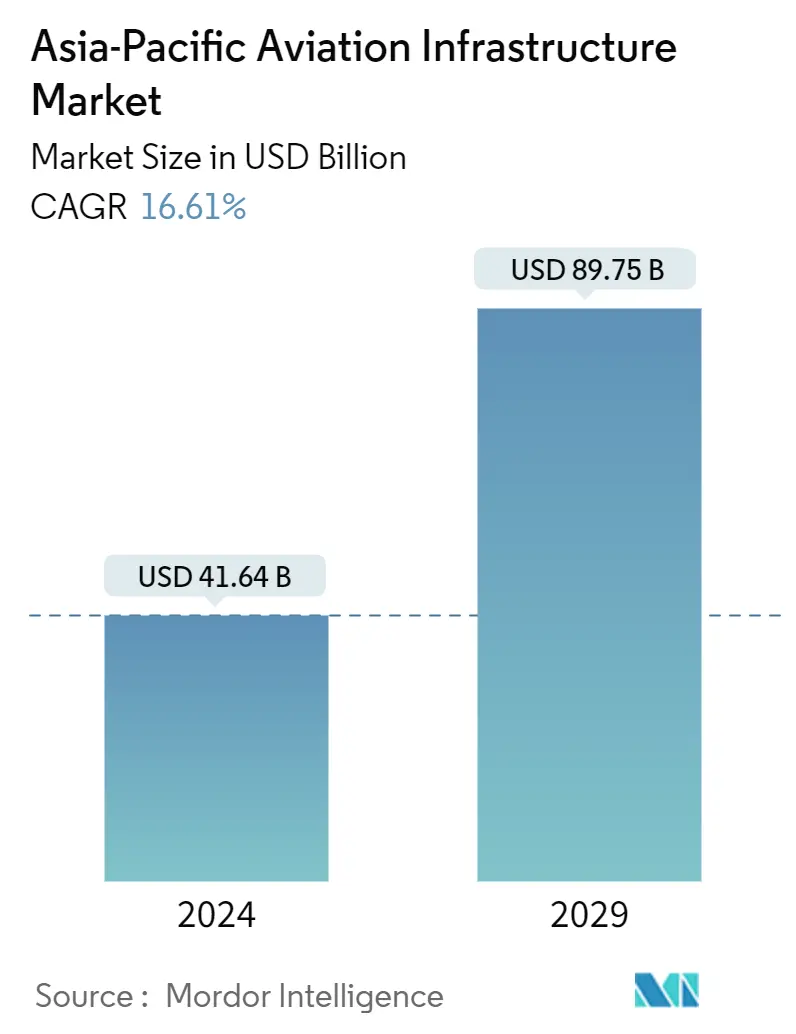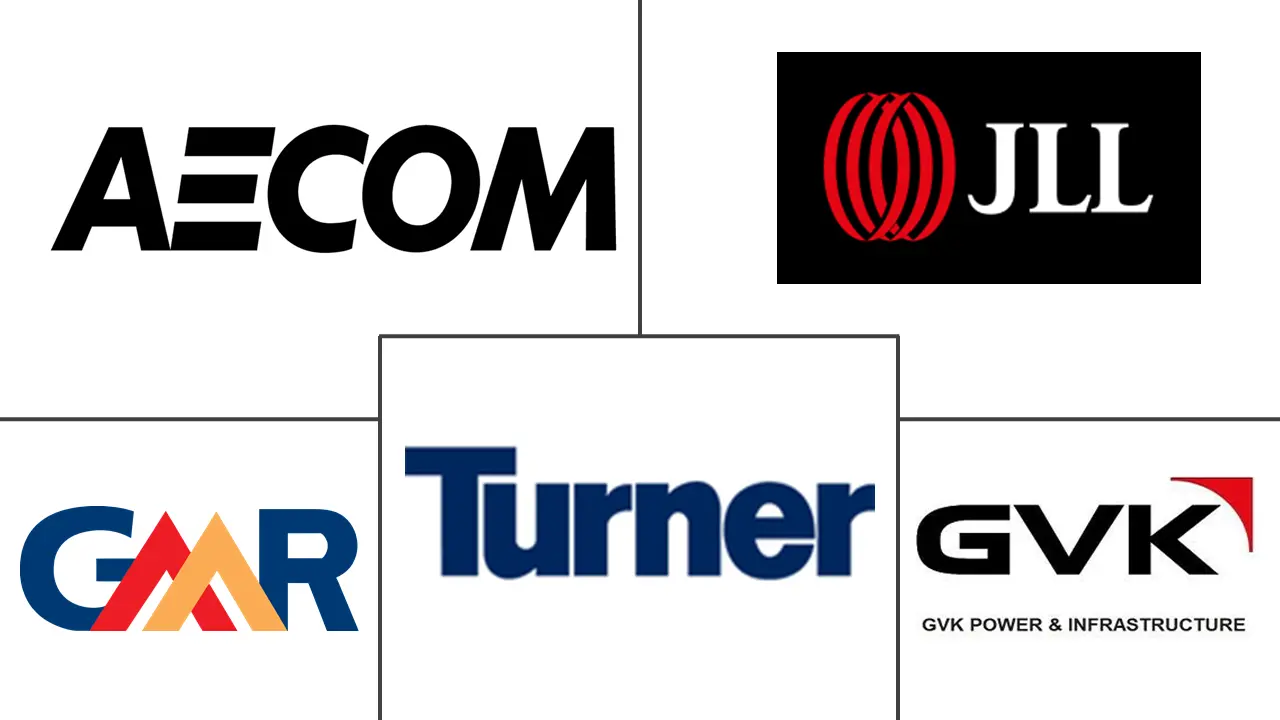Market Size of Asia-Pacific Aviation Infrastructure Industry

| Study Period | 2019 - 2029 |
| Base Year For Estimation | 2023 |
| Market Size (2024) | USD 41.64 Billion |
| Market Size (2029) | USD 89.75 Billion |
| CAGR (2024 - 2029) | 16.61 % |
| Market Concentration | Medium |
Major Players
*Disclaimer: Major Players sorted in no particular order |
Asia-Pacific Aviation Infrastructure Market Analysis
The Asia-Pacific Aviation Infrastructure Market size is estimated at USD 41.64 billion in 2024, and is expected to reach USD 89.75 billion by 2029, growing at a CAGR of 16.61% during the forecast period (2024-2029).
The COVID-19 pandemic had a significant impact on all sectors, including the aviation industry. Due to restrictions on air travel, the overall passenger traffic declined by 60% to 65%. However, as the situation normalized in the fiscal year 2021-2022, the number of air passengers increased, leading to the unfreezing of standby orders of commercial aircraft and an increase in orders from airline companies. As of December 2022, the total traffic measured in revenue passenger kilometers (RPKs) rose by 39.9% compared to December 2021. Global traffic was then at 76.9% of the levels seen in December 2021.
In the Asia-Pacific region, the COVID-19 pandemic resulted in a decline in sales of aircraft in the commercial and general aviation segments in 2020. In the commercial sector, international passenger traffic continued to remain low in 2021. Nevertheless, domestic passenger traffic has been robustly growing in various countries since late 2020. A similar trend was witnessed in the general aviation sector in 2021 as the aircraft movement significantly increased compared to 2020. In Asia-Pacific, passenger and freight traffic rates are increasing, thus boosting the number of aircraft being handled by airports. This is propelling the demand for efficient and better ground handling systems and infrastructure at terminals. Due to the growing number of air passengers, several airports in the region need help with capacity management and other issues.
The airport infrastructure market in smaller cities in countries such as India and China is expected to witness growth, owing to the efforts taken by governments to promote air travel. As modern airports are being constructed with more terminal gates, longer runways, and advanced air traffic control systems, a rise in the demand for these infrastructure components is expected to propel the aviation infrastructure market in the Asia-Pacific region.
Asia-Pacific Aviation Infrastructure Industry Segmentation
Aviation infrastructure refers to the physical facilities and systems that support the operation of aircraft, airports, and air navigation. It encompasses a wide range of components necessary for the safe, efficient, and reliable functioning of air transportation.
The Asia-Pacific aviation infrastructure market is segmented by airport type, infrastructure type, and geography. By airport type, the market is segmented into commercial airports, military airports, and general aviation airports. By infrastructure type, the market is segmented into terminals, control towers, taxiways and runways, aprons, hangars, and other infrastructure types. The report also offers the market size and forecasts for the aviation infrastructure market in major countries in the region. The study considers the planned investments for new airport construction, as well as the modernization plans for existing airports in the region. For each segment, the market size and forecasts are represented by value (USD).
| Airport Type | |
| Commercial Airport | |
| Military Airport | |
| General Aviation Airport |
| Infrastructure Type | |
| Terminal | |
| Control Tower | |
| Taxiway and Runway | |
| Apron | |
| Hangars | |
| Other Infrastructure Types |
| Geography | ||||||||
|
Asia-Pacific Aviation Infrastructure Market Size Summary
The Asia-Pacific aviation infrastructure market is poised for significant growth, driven by the resurgence of air travel and increased demand for modernized airport facilities. Following the disruptions caused by the COVID-19 pandemic, the region has seen a robust recovery in domestic passenger traffic, with international travel also picking up. This resurgence has led to a surge in aircraft orders and a pressing need for enhanced ground handling systems and terminal infrastructure. Governments in countries like India and China are actively promoting air travel, resulting in the construction of new airports and the expansion of existing ones. These developments are expected to bolster the market, as modern airports with advanced air traffic control systems and increased capacity are being prioritized to accommodate the growing number of air passengers and freight traffic.
China stands out as a dominant player in the region, with substantial investments in aviation infrastructure and a strategic focus on expanding its airport network. The country's ambitious plans to add numerous airports by 2035 and the significant procurement of new aircraft underscore its commitment to transforming aviation into a key economic asset. The market is semi-consolidated, with major players like GMR Group, GVK Industries Limited, and AECOM Limited playing pivotal roles in infrastructure development. These companies are collaborating closely with airport authorities to enhance operational efficiency and meet the rising demand for air travel. As the region continues to expand its aviation capabilities, the market is expected to experience heightened competition and growth, supported by ongoing infrastructure projects and strategic investments.
Asia-Pacific Aviation Infrastructure Market Size - Table of Contents
-
1. MARKET DYNAMICS
-
1.1 Market Overview
-
1.2 Market Drivers
-
1.3 Market Restraints
-
1.4 Porter's Five Forces Analysis
-
1.4.1 Bargaining Power of Buyers/Consumers
-
1.4.2 Bargaining Power of Suppliers
-
1.4.3 Threat of New Entrants
-
1.4.4 Threat of Substitute Products
-
1.4.5 Intensity of Competitive Rivalry
-
-
-
2. MARKET SEGMENTATION
-
2.1 Airport Type
-
2.1.1 Commercial Airport
-
2.1.2 Military Airport
-
2.1.3 General Aviation Airport
-
-
2.2 Infrastructure Type
-
2.2.1 Terminal
-
2.2.2 Control Tower
-
2.2.3 Taxiway and Runway
-
2.2.4 Apron
-
2.2.5 Hangars
-
2.2.6 Other Infrastructure Types
-
-
2.3 Geography
-
2.3.1 Asia-Pacific
-
2.3.1.1 China
-
2.3.1.2 India
-
2.3.1.3 Japan
-
2.3.1.4 South Korea
-
2.3.1.5 Australia
-
2.3.1.6 Rest of Asia-Pacific
-
-
-
Asia-Pacific Aviation Infrastructure Market Size FAQs
How big is the Asia-Pacific Aviation Infrastructure Market?
The Asia-Pacific Aviation Infrastructure Market size is expected to reach USD 41.64 billion in 2024 and grow at a CAGR of 16.61% to reach USD 89.75 billion by 2029.
What is the current Asia-Pacific Aviation Infrastructure Market size?
In 2024, the Asia-Pacific Aviation Infrastructure Market size is expected to reach USD 41.64 billion.

